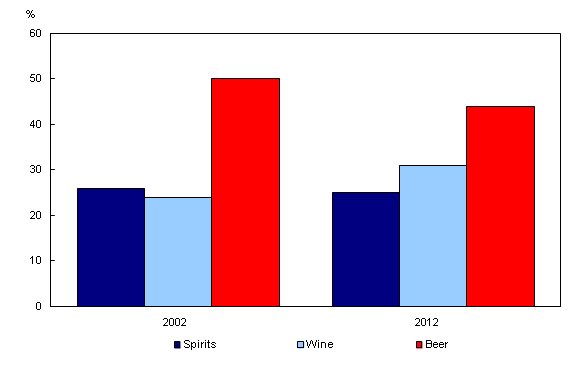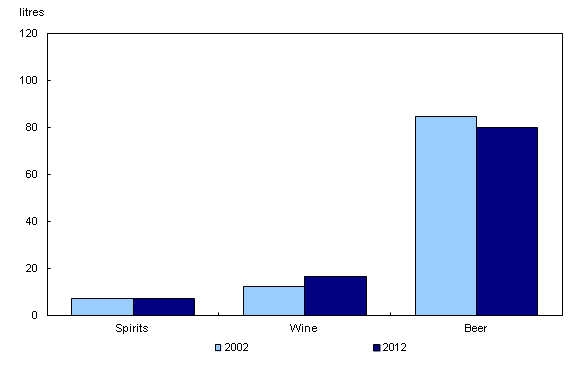Control and sale of alcoholic beverages, for the year ending March 31, 2012 (correction)
Archived Content
Information identified as archived is provided for reference, research or recordkeeping purposes. It is not subject to the Government of Canada Web Standards and has not been altered or updated since it was archived. Please "contact us" to request a format other than those available.
Released: 2013-04-11
Beer and liquor stores and agencies sold $20.9 billion worth of alcoholic beverages during the fiscal year ending March 31, 2012, up 3.0% from the previous year.
Beer remained the alcoholic drink of choice for Canadians, but preferences are changing.
While the growth in the dollar value of sales reflected an increase in all three market segments, the growth in wine sales (+5.9%) in 2012 outpaced the growth in both beer (+0.6%) and spirit (+3.9%) sales.
Correction: In litres of absolute alcohol, the volume of sales of alcoholic beverages increased 2.1% to 233.0 million litres.
The net income realized by provincial and territorial liquor authorities, combined with other alcohol-related revenue, such as liquor licences and permits, was up 3.6% from the previous year to $6.1 billion in 2012. Nova Scotia and the Northwest Territories were the only jurisdictions to report net income declines.
Market share of beer on the decline
Beer, liquor stores and agencies sold $9.2 billion worth of beer during the fiscal year ending March 31, 2012, up 0.6% from the previous year. Alberta reported the largest sales increase at 7.1%, while Quebec (-3.9%) posted the biggest decline.
Despite the small increase in beer sales, both in terms of volume and dollar value, the market share dominance of beer continued to decline as consumers turned more to wine.
In 2002, beer had a market share of 50% by dollar value, while wine had 24%. By 2012, the market share for beer had declined to 44%, while wine accounted for 31%.
Measuring volume, beer stores and agencies sold 2.3 billion litres of beer in 2012. The volume of domestic beer sold increased to 1,994.0 million litres in 2012, up 1.4% from the previous year. The volume of imported beer sold increased 0.7% to 323.0 million litres. Over a 10-year period, the market share of domestic beer sold in Canada decreased from 92% in 2002 to 86% in 2012.
Overall, three countries accounted for 60% of imported beer sales in terms of volume. The United States led the imported beer market at 23.5%, followed by the Netherlands (19.2%) and Mexico (17.0%).
On a per-capita basis, beer sales amounted to 80.3 litres per person in 2012, down from 84.9 litres in 2002. In contrast, during the same period, beer sales, in terms of dollar value, increased by almost $30 to $317 per person.
Wine's popularity still on the rise
Wineries and liquor stores and agencies sold $6.5 billion worth of wines during the year ending March 31, 2012, up 5.9% from the previous year. All provinces and territories reported gains except Nunavut (-6.9%).
In terms of volume, wine sales increased 3.8% from 2011 to 488.0 million litres in 2012. The growth in volume of imported wine (+4.5%) outpaced the growth of domestic wine (+2.8%).
The market shares of red and white wine have shifted over the past 10 years. In 2012, red wine represented 57% of total wine sales compared with 48% in 2002.
The share of imported red wine in 2012 was unchanged compared with 2011 at 76% of all red wines sold in Canada. The market share of imported white wine was smaller at 63%.
On a per-capita basis, wine sales amounted to 16.9 litres or $225 per person in 2012, an increase of 4.3 litres per person from 2002.
Whisky and liqueur sales on the rise
Liquor stores and agencies sold $5.3 billion worth of spirits during the year ending March 31, 2012, up 3.9% from the previous year. This gain was mainly the result of growth in the sales of whisky (+4.7%) and liqueurs (+2.0%).
The volume of spirits sold increased 3.2% in 2012 to 216.6 million litres. Although the volume of domestic spirits sold increased 3.9% to 144.9 million litres in 2012, the market share for these spirits has been on the decline. Over a 10-year period, the market share of domestic spirits decreased from 74% in 2002 to 67% in 2012.
In terms of dollar value, nearly 70% of the imported spirits sold in Canada were from the United States (27.4%), the United Kingdom (27.3%) and France (14.3%). Spirits imported from Mexico continue to gain popularity year over year, increasing from a share of 4.7% in 2011 to 6.6% in 2012.
Whisky-type products such as whisky, scotch, and bourbon accounted for 27% of total spirits sales (in dollar value) in 2012, followed by vodka sales at 24% and rum sales at 17%.
On a per-capita basis, spirits sales amounted to 7.5 litres per person in 2012, a marginal increase of 0.3 litres per person from 2002. Despite the increase in per capita sales, the market share of spirits declined from 26% in 2002 to 25% in 2012.
Note to readers
Statistics on the sales of alcoholic beverages by volume should not be equated with data on consumption. Sales volumes include only sales by liquor authorities and their agents, and sales by wineries and breweries and outlets that operate under license from the liquor authorities.
Consumption of alcoholic beverages would include all these sales, plus homemade wine and beer, wine and beer manufactured through brew-on-premises operations, sales in duty-free shops and any unrecorded transactions.
Similarly, statistics on sales of alcoholic beverages by dollar value of sales should not be equated with consumer spending on alcoholic beverages. Sales data refer to the revenues received by liquor authorities, wineries and breweries. These revenues include sales to licensed establishments, such as bars and restaurants.
Therefore, sales data do not reflect the total amount spent by consumers on alcoholic beverages, since the prices paid in licensed establishments are greater than the price paid by those establishments to the liquor authorities.
Per capita data are based on the population aged 15 and over as per CANSIM table 051-0001 for July 1, 2011, to conform to internationally accepted standards. Volume of sales of alcoholic beverages in litres of absolute alcohol is calculated by multiplying the sales volume by the percentage of alcohol content. For more information, consult the "Definitions, data sources and methods" section of this release.
The data for the provinces of Newfoundland and Labrador and of Quebec cover a period of 53 weeks for the fiscal year ending March 31, 2012.
Data tables on sales of alcoholic beverages are available from the National economic accounts module of our website.
Data are also available through custom and special tabulation.
Contact information
For more information of this release, contact us (toll-free 1-800-263-1136; infostats@statcan.gc.ca).
To enquire about the concepts, methods or data quality of this release, contact Hiren Parikh (613-951-6695; hiren.parikh@statcan.gc.ca) or Bruce Orok (613-951-0181; bruce.orok@statcan.gc.ca), Public Sector Statistics Division.
- Date modified:



